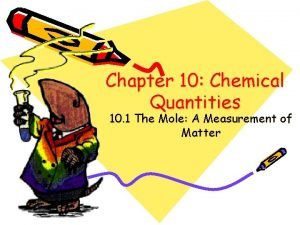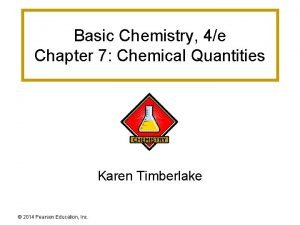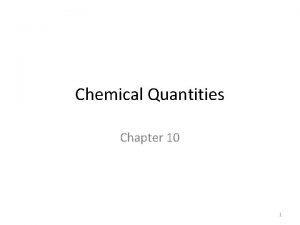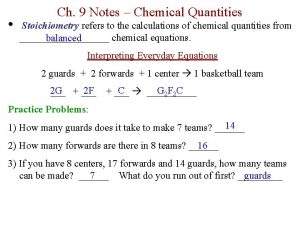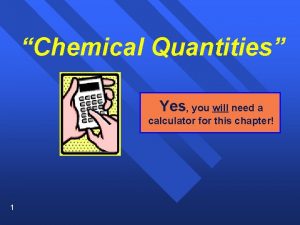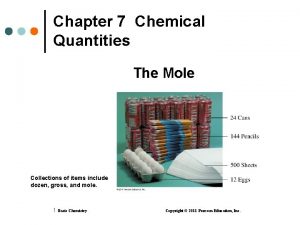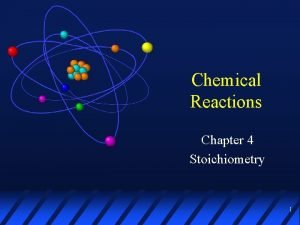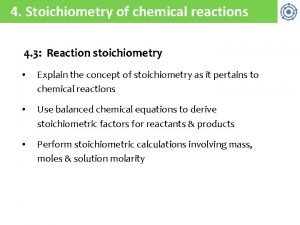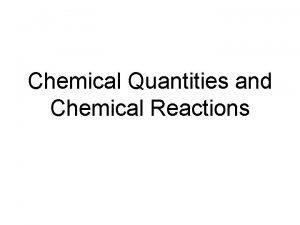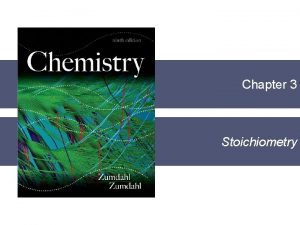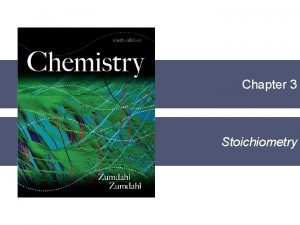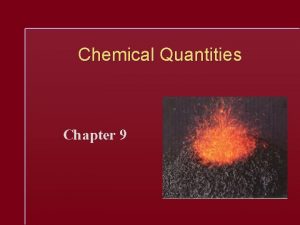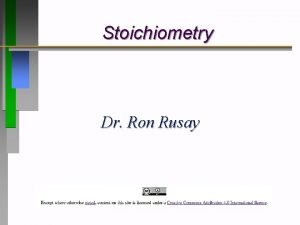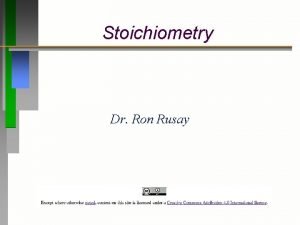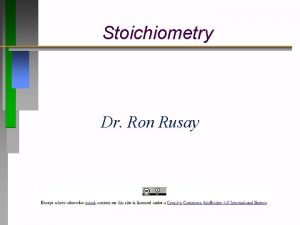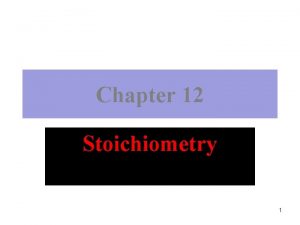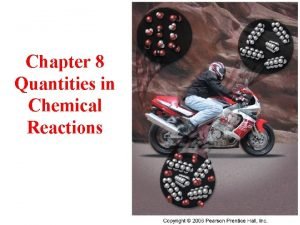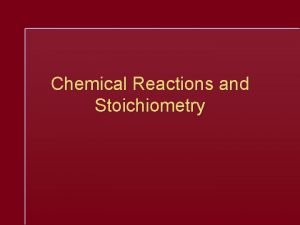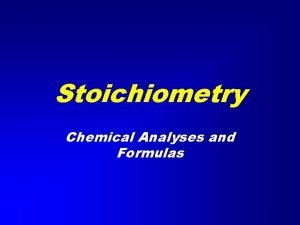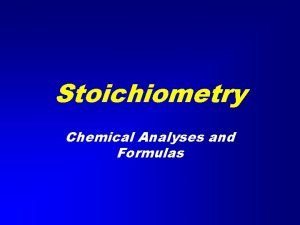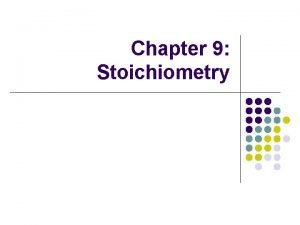Chapter 9 Chemical Quantities STOICHIOMETRY Stoichiometry is the


































- Slides: 34

Chapter 9 Chemical Quantities

STOICHIOMETRY Stoichiometry is the use of balanced chemical equations in the conversion process. Examples Calculate the mass of water formed from 6. 33 g of hydrogen. A balanced equation is required. 2 H 2 + O 2 2 H 2 O 6. 33 g H 2

STOICHIOMETRY Stoichiometry is the use of balanced chemical equations in the conversion process. Examples Calculate the mass of water formed from 6. 33 g of hydrogen. A balanced equation is required. 2 H 2 + O 2 2 H 2 O 6. 33 g H 2 Mole H 2 2. 016 g H 2

STOICHIOMETRY Stoichiometry is the use of balanced chemical equations in the conversion process. Examples Calculate the mass of water formed from 6. 33 g of hydrogen. A balanced equation is required. 2 H 2 + O 2 2 H 2 O 6. 33 g H 2 Mole H 2 2. 016 g H 2

STOICHIOMETRY Stoichiometry is the use of balanced chemical equations in the conversion process. Examples Calculate the mass of water formed from 6. 33 g of hydrogen. A balanced equation is required. 2 H 2 + O 2 2 H 2 O 6. 33 g H 2 Mole H 2 2. 016 g H 2 O Mole H 2 O 2 Mole H 2

STOICHIOMETRY Stoichiometry is the use of balanced chemical equations in the conversion process. Examples Calculate the mass of water formed from 6. 33 g of hydrogen. A balanced equation is required. 2 H 2 + O 2 2 H 2 O 6. 33 g H 2 Mole H 2 2. 016 g H 2 Mole H 2 O 18. 02 g H 2 O = 28. 3 g H 2 O 2 Mole H 2 O

Excess and Limiting Reactants are substances that can be changed into something else. For example, nails and boards are reactants for carpenters, while thread and fabric are reactants for the seamstress. And for a chemist hydrogen and oxygen are reactants for making water.

Building Houses Ok, we want to build some houses, so we order 2 truck loads of boards and 2 truck loads of nails. If two truck loads of boards make one house and two truck loads of nails make 10 houses, then how many houses can we make?

Building Houses Ok, we want to build some houses, so we order 2 truck loads of boards and 2 truck loads of nails. If two truck loads of boards make one house and two truck loads of nails make 10 houses, then how many houses can we make? Yes, only one house!

Building Houses Ok, we want to build some houses, so we order 2 truck loads of boards and 2 truck loads of nails. If two truck loads of boards make one house and two truck loads of nails make 10 houses, then how many houses can we make? What reactant is in excess? And how many more houses could we use if we had enough boards?

Building Houses Ok, we want to build some houses, so we order 2 truck loads of boards and 2 truck loads of nails. If two truck loads of boards make one house and two truck loads of nails make 10 houses, then how many houses can we make? What reactant is in excess? And how many more houses could we use if we have enough boards?

Building Houses Ok, we want to build some houses, so we order 2 truck loads of boards and 2 truck loads of nails. If two truck loads of boards make one house and two truck loads of nails make 10 houses, then how many houses can we make? What reactant is in excess? And how many more houses could we use if we have enough boards? Yes, nails are in excess!

Building Houses Ok, we want to build some houses, so we order 2 truck loads of boards and 2 truck loads of nails. If two truck loads of boards make one house and two truck loads of nails make 10 houses, then how many houses can we make? What reactant is in excess? And how many more houses could we use if we have enough boards? Yes, nails are in excess! Nine more houses if we have an adequate amount of boards.

Making Water If we react 10. 0 g of hydrogen with 10. 0 g of oxygen, which, if any, reactant will be in excess?

Making Water If we react 10. 0 g of hydrogen with 10. 0 g of oxygen, which, if any, reactant will be in excess? Our conversion process can easily determine the excess reactant. We can convert 10. 0 g of oxygen to grams of hydrogen to determine if there is enough hydrogen to consume the oxygen.

Making Water If we react 10. 0 g of hydrogen with 10. 0 g of oxygen, which, if any, reactant will be in excess? Our conversion process can easily determine the excess reactant. We can convert 10. 0 g of oxygen to grams of hydrogen to determine if there is enough hydrogen to consume the oxygen. 2 H 2 + O 2 10. 0 g O 2 2 H 2 O

Making Water If we react 10. 0 g of hydrogen with 10. 0 g of oxygen, which, if any, reactant will be in excess? Our conversion process can easily determine the excess reactant. We can convert 10. 0 g of oxygen to grams of hydrogen to determine if there is enough hydrogen to consume the oxygen. 2 H 2 + O 2 10. 0 g O 2 mole O 2 32. 0 g O 2 2 H 2 O

Making Water If we react 10. 0 g of hydrogen with 10. 0 g of oxygen, which, if any, reactant will be in excess? Our conversion process can easily determine the excess reactant. We can convert 10. 0 g of oxygen to grams of hydrogen to determine if there is enough hydrogen to consume the oxygen. 2 H 2 + O 2 10. 0 g O 2 mole O 2 2 mole H 2 32. 0 g O 2 mole O 2 2 H 2 O

Making Water If we react 10. 0 g of hydrogen with 10. 0 g of oxygen, which, if any, reactant will be in excess? Our conversion process can easily determine the excess reactant. We can convert 10. 0 g of oxygen to grams of hydrogen to determine if there is enough hydrogen to consume the oxygen. 2 H 2 + O 2 2 H 2 O 10. 0 g O 2 mole O 2 2 mole H 2 2. 02 g H 2 32. 0 g O 2 mole H 2

Making Water If we react 10. 0 g of hydrogen with 10. 0 g of oxygen, which, if any, reactant will be in excess? Our conversion process can easily determine the excess reactant. We can convert 10. 0 g of oxygen to grams of hydrogen to determine if there is enough hydrogen to consume the oxygen. 2 H 2 + O 2 2 H 2 O 10. 0 g O 2 mole O 2 2 mole H 2 2. 02 g H 2 = 1. 26 g H 2 32. 0 g O 2 mole H 2

Making Water Only 1. 26 g of hydrogen are required to react with 10. 0 g of oxygen. Since there are 10. 0 g of hydrogen available, then hydrogen must be the excess reactant and oxygen is the limiting reactant. The remainder of hydrogen 10. 0 1. 26 = 8. 7 g is called the amount in excess. The amount of water produced is determined by using the limiting reactant and converting it into water.

Making Water Only 1. 26 g of hydrogen are required to react with 10. 0 g of oxygen. Since there are 10. 0 g of hydrogen available, then hydrogen must be the excess reactant and oxygen is the limiting reactant. The remainder of hydrogen 10. 0 1. 26 = 8. 7 g is called the amount in excess. The amount of water produced is determined by using the limiting reactant and converting it into water. 10. 0 g O 2 mole O 2 32. 0 g O 2

Making Water Only 1. 26 g of hydrogen are required to react with 10. 0 g of oxygen. Since there are 10. 0 g of hydrogen available, then hydrogen must be the excess reactant and oxygen is the limiting reactant. The remainder of hydrogen 10. 0 1. 26 = 8. 7 g is called the amount in excess. The amount of water produced is determined by using the limiting reactant and converting it into water. 10. 0 g O 2 mole O 2 2 mole H 2 O 32. 0 g O 2 mole O 2

Making Water Only 1. 26 g of hydrogen are required to react with 10. 0 g of oxygen. Since there are 10. 0 g of hydrogen available, then hydrogen must be the excess reactant and oxygen is the limiting reactant. The remainder of hydrogen 10. 0 1. 26 = 8. 7 g is called the amount in excess. The amount of water produced is determined by using the limiting reactant and converting it into water. 10. 0 g O 2 mole O 2 2 mole H 2 O 18. 0 g H 2 O mole H 2 O 32. 0 g O 2 mole O 2

Making Water Only 1. 26 g of hydrogen are required to react with 10. 0 g of oxygen. Since there are 10. 0 g of hydrogen available, then hydrogen must be the excess reactant and oxygen is the limiting reactant. The remainder of hydrogen 10. 0 1. 26 = 8. 7 g is called the amount in excess. The amount of water produced is determined by using the limiting reactant and converting it into water. 10. 0 g O 2 mole O 2 2 mole H 2 O 18. 0 g H 2 O = 11. 3 g H O 2 mole H 2 O 32. 0 g O 2 mole O 2

Percentage Yield The percent yield is a comparison of the laboratory answer to the correct answer which is determined by the conversion process. Suppose a student combined 10. 0 g of oxygen and 10. 0 g of hydrogen in the lab and recovered 8. 66 g of water. What would be the percent yield?

Percentage Yield The percent yield is a comparison of the laboratory answer to the correct answer which is determined by the conversion process. Suppose a student combined 10. 0 g of oxygen and 10. 0 g of hydrogen in the lab and recovered 8. 66 g of water. What would be the percent yield? Yield (the lab amount) X 100 percent yield = Theoretical Yield (by conversions) percent yield = 8. 66 X 100 = 76. 6% 11. 3

Thermochemical Equations When a chemical or physical change takes place energy is either lost of gained. A Thermochemical equation describes this change. Equations gaining energy are called endothermic and equations losing energy are called exothermic.

Thermochemical Equations When a chemical or physical change takes place energy is either lost of gained. A Thermochemical equation describes this change. Equations gaining energy are called endothermic and equations losing energy are called exothermic. Examples: C 3 H 6 O (l ) H 2 O (l) 4 O 2 (g) 3 CO 2(g) + 3 H 2 O (g) Exothermic H 2 O (g) ΔH = 44. 01 kj Endothermic ΔH = -1790 kj

Thermochemical Conversions How many kj of heat are released when 709 g of C 3 H 6 O are burned?

Thermochemical Conversions How many kj of heat are released when 709 g of C 3 H 6 O are burned? C 3 H 6 O (l ) 4 O 2 (g) 3 CO 2(g) + 3 H 2 O (g) ΔH = -1790 kj 709 g C 3 H 6 O mole C 3 H 6 O 58. 1 g C 3 H 6 O

Thermochemical Conversions How many kj of heat are released when 709 g of C 3 H 6 O are burned? C 3 H 6 O (l ) 4 O 2 (g) 3 CO 2(g) + 3 H 2 O (g) ΔH = -1790 kj 709 g C 3 H 6 O mole C 3 H 6 O 58. 1 g C 3 H 6 O

Thermochemical Conversions How many kj of heat are released when 709 g of C 3 H 6 O are burned? C 3 H 6 O (l ) 4 O 2 (g) 709 g C 3 H 6 O mole C 3 H 6 O 3 CO 2(g) + 3 H 2 O (g) ΔH = -1790 kj 58. 1 g C 3 H 6 O mole C 3 H 6 O = 21800 kj

The End
 Angular velocity to linear velocity
Angular velocity to linear velocity Chapter 7 chemical quantities answer key
Chapter 7 chemical quantities answer key Chemistry chapter 10 chemical quantities
Chemistry chapter 10 chemical quantities Chapter 7 chemical quantities answer key
Chapter 7 chemical quantities answer key Chemical quantities chapter 10
Chemical quantities chapter 10 Chapter 10 chemical quantities practice problems answer key
Chapter 10 chemical quantities practice problems answer key Chapter 9 chemical quantities
Chapter 9 chemical quantities The calculation of quantities in chemical reactions
The calculation of quantities in chemical reactions The calculation of quantities in chemical equations
The calculation of quantities in chemical equations Chemical quantities calculator
Chemical quantities calculator Unit chemical quantities the mole 1 step
Unit chemical quantities the mole 1 step Empirical formula pogil
Empirical formula pogil Modern chemistry chapter 7 test
Modern chemistry chapter 7 test Are kc and kp equal
Are kc and kp equal Chemical rxns/balancing equ./stoichiometry
Chemical rxns/balancing equ./stoichiometry In a chemical reaction, stoichiometry refers to:
In a chemical reaction, stoichiometry refers to: Types of chemical reactions and solution stoichiometry
Types of chemical reactions and solution stoichiometry Types of chemical reactions and solution stoichiometry
Types of chemical reactions and solution stoichiometry Chemical accounting: stoichiometry
Chemical accounting: stoichiometry Chemical accounting stoichiometry
Chemical accounting stoichiometry Stoichiometry map for chemical reactions
Stoichiometry map for chemical reactions Chapter 11 study guide stoichiometry
Chapter 11 study guide stoichiometry Units physical quantities and measurements
Units physical quantities and measurements Section 2 classifying chemical reactions worksheet answers
Section 2 classifying chemical reactions worksheet answers Chemical reactions section 2 classifying chemical reactions
Chemical reactions section 2 classifying chemical reactions Section 1 chemical changes
Section 1 chemical changes Hát kết hợp bộ gõ cơ thể
Hát kết hợp bộ gõ cơ thể Lp html
Lp html Bổ thể
Bổ thể Tỉ lệ cơ thể trẻ em
Tỉ lệ cơ thể trẻ em Voi kéo gỗ như thế nào
Voi kéo gỗ như thế nào Tư thế worm breton
Tư thế worm breton Bài hát chúa yêu trần thế alleluia
Bài hát chúa yêu trần thế alleluia Môn thể thao bắt đầu bằng từ chạy
Môn thể thao bắt đầu bằng từ chạy Thế nào là hệ số cao nhất
Thế nào là hệ số cao nhất


